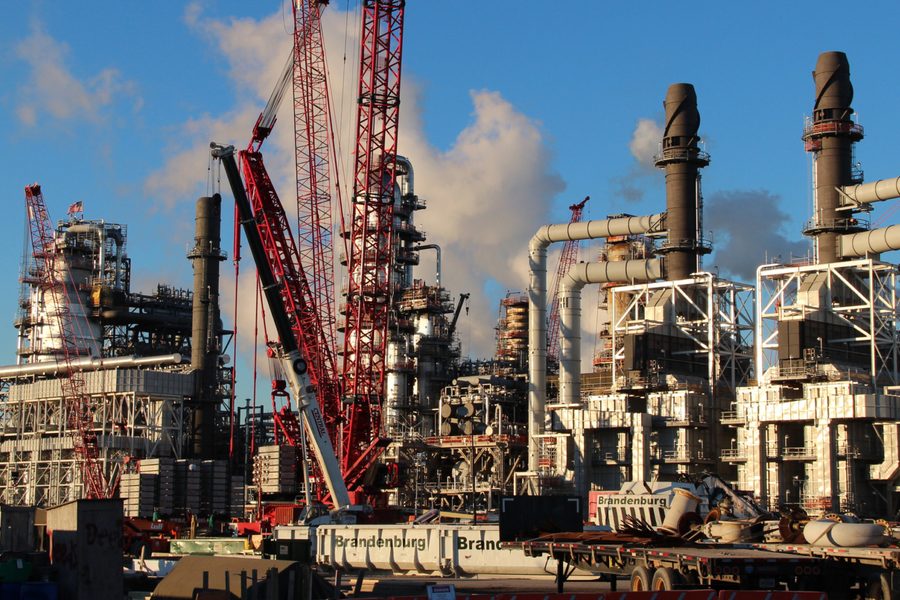
EAST CHICAGO, IND. — It was shift-change time at BP’s massive oil refinery in northwest Indiana, and hundreds of workers beginning or ending their workdays streamed through the security gates. The sun set before them on a staggering industrial landscape: countless smokestacks, flares, towers, tanks and other infrastructure for the oil refinery and nearby operations, including a steel mill and a tin plant.
At the same time, about a mile away in the East Chicago Public Library, a father-son team of development consultants were talking with a crowd of largely frustrated and confused residents about the latest plan to revitalize the struggling town of 30,000.
The meeting showed how difficult it can be to create jobs in a community riven by a lack of education, disinvestment, crime, foreclosures and other factors – even in a hive of industry like East Chicago. When asked by In These Times whether they know anyone who works at the BP refinery or the nearby ArcelorMittal steel mill, a residents responded, “No one does.” “No way.” “It’s all people from outside.”
The city’s new redevelopment scheme is a $2.6 million revitalization and job-creation plan, funded with federal dollars and aimed specifically at East Chicago’s North Harbor area, near Lake Michigan. The goal is to spark new retail and residential development that will bring in visitors and create jobs.
At the library meeting on January 24, a trio was busily selling the plan. East Chicago redevelopment commissioner Maria Becerra and father-son development team Walter Haglund and Karl Haglun outlined ambitious goals: providing childcare services so single mothers can pursue education or training; helping residents with criminal backgrounds get jobs.
But the challenges facing revitalization in East Chicago are formidable. The median income is $26,538, and a high proportion of local residents dropped out of school as early as eighth grade. Federal numbers show that unemployment in East Chicago has swung between 12 and 16 percent over the past two years, while overall Indiana unemployment has been 8 percent. However, some residents say true unemployment is much higher, since many residents have stopped looking for jobs and thus are not reflected in the federal statistics.
In a PowerPoint presentation, Haglund outlined for the residents the challenges that most of them already know all too well: the vacant buildings that attract crack addicts, high crime levels that scare away would-be investors, and the lack of local businesses and jobs.
Haglund explained that the federal program offers substantial funding for people seeking to buy or renovate homes. But residents at the meeting weren’t overly impressed. “No one wants to buy a home in East Chicago, because you can’t sell a home here,” said one attendee. Several complained about how they had filled out forms for government housing subsidies in the past and never heard back. Another man said he was trying to be a responsible property owner and take “pride” in his community, but he couldn’t find dependable tenants for his rental units. Even a few blocks from a police station, no one wanted to live in his building, he said.
A memory of better times
A number of people at the meeting were residents of Marktown, an historic former company town built to house workers of a now-demolished steel mill. Though it is part of East Chicago, Marktown is set apart from other residential neighborhoods, directly adjacent to the BP refinery. Marktown residents present at the meeting said that very few people who live in the neighbor work at the refinery, though they deal with the air pollution from its stacks and the heavy truck traffic it creates.
Thomas told In These Times that it is common to see the refinery parking lot full of cars and trucks with out-of-state license plates, and to see workers driving to area hotels or commuting from more upscale towns an hour or more away, in Illinois, Michigan or Indiana. Thomas said locals don’t have and aren’t getting the training for the well-paying refinery and steel jobs, even though there are several community colleges and technical institutes in the area.
At the meeting at the library, Kim Rodriguez, a lifelong resident of Marktown — which is not part of the North Harbor revitalization program — told development commissioner Becerra that Marktown residents had developed a formal revitalization plan in 2008 and presented it to East Chicago authorities, with no response.
“How many plans are going to be put in place before you follow through on them?” she asked. Becerra responded that because she just took office in June, she wasn’t aware of the 2008 plan and would be willing to meet with Marktown residents.
Rodriguez and several of her neighbors seemed guardedly hopeful. Given Marktown’s history as part of the thriving industrial base that built this region, residents say that the town, where one in four homes is now vacant and many are crumbling and decrepit, should be rehabbed and celebrated. Thomas, though not a Marktown resident herself, told In These Times, “If I had a million dollars I would buy [Marktown] and turn it into something quaint, with stores, a little place you could drink wine.”
Marktown vs. boomtown
This stretch of Northwest Indiana could actually be seen as something of a modern-day “boomtown” of the type created by sudden, lucrative and often temporary oil and gas extraction projects around the country. That’s because BP is in the midst of a $3.8 billion expansion to process Canadian tar sands oil, a project that has created 8,000 temporary construction jobs and drawn many workers from around the region and out of state. Once construction is complete, the tar sands expansion will have created 1,850 new jobs, according to BP. Residents say they hope to get some of the jobs, but they worry that many locals don’t have the necessary training.
Residents of Marktown and other parts of East Chicago frequently stress that their neighborhoods grew up in the midst of heavy industry, and they have nothing against the industrial presence. They just want to share in the prosperity that all this activity generates for others.
Instead, Marktown’s very existence may be threatened by the BP refinery, since the company has recently made clear it is looking to buy up and raze nearby properties. Local residents said that given the high unemployment in the area, the money offered by BP might seem attractive. But due to the low property values in Marktown, selling out might offer little more than a temporary and small windfall that leaves people worse off than before.
“BP needs to join with us in the financial cost of restoring our homes,” Rodriguez said at a gathering in Marktown the day before the East Chicago revitalization meeting. “They can show that an oil refinery and a historic community can safely coexist side by side.”

I hope you found this article important. Before you leave, I want to ask you to consider supporting our work with a donation. In These Times needs readers like you to help sustain our mission. We don’t depend on—or want—corporate advertising or deep-pocketed billionaires to fund our journalism. We’re supported by you, the reader, so we can focus on covering the issues that matter most to the progressive movement without fear or compromise.
Our work isn’t hidden behind a paywall because of people like you who support our journalism. We want to keep it that way. If you value the work we do and the movements we cover, please consider donating to In These Times.
Kari Lydersen is a Chicago-based journalist, author and assistant professor at Northwestern University, where she leads the investigative specialization at the Medill School of Journalism, Media, Integrated Marketing Communications. Her books include Mayor 1%: Rahm Emanuel and the Rise of Chicago’s 99%.







